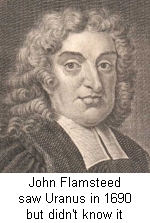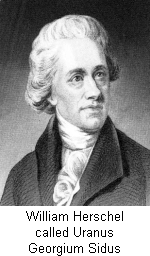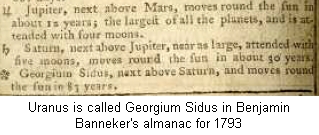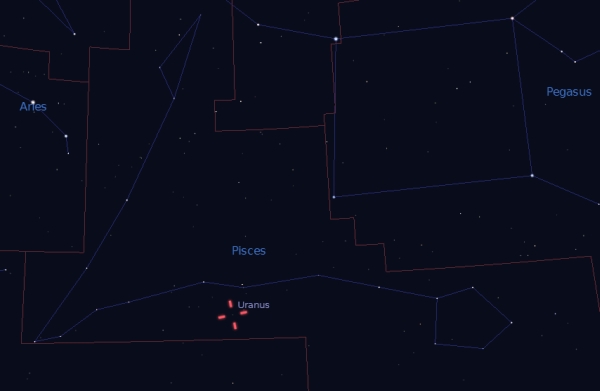¡SkyCaramba! Weekly astronomy blog for the week ending October 11, 2014
A frozen blue-green ball that orbits the sun beyond Saturn has the distinction of being the first planet discovered with a telescope, although it isn’t completely invisible without one. Probably, someone saw Uranus  thousands of years ago but never gave it much thought.
thousands of years ago but never gave it much thought.
William Herschel spotted Uranus in 1781. At first he thought it was a comet, because it looked fuzzy. It moved from night to night, like a comet. But it didn’t move as fast as other comets known until Herschel’s time. After a few weeks of observation and calculating its orbit, Herschel concluded he was looking at a planet.
Herschel was born in Germany but had moved to Britain. He made money as a musician, but wanted to work as an astronomer. When King George III learned of Herschel’s discovery, he granted Herschel £200 per year to underwrite his astronomy work. In honor of the king, Herschel named the planet Georgium Sidus or “the Georgian Planet”.
Herschel felt that naming the planet after an earthly king reflected a new era in discovery. But with other  planets named after ancient Greek gods, Georgium Sidus didn’t stick. People eventually went with astronomer Johann Bode’s suggestion to call it Uranus.
planets named after ancient Greek gods, Georgium Sidus didn’t stick. People eventually went with astronomer Johann Bode’s suggestion to call it Uranus.
Uranus is slightly brighter than sixth magnitude, the limit for what the human eye can see without binoculars or a telescope. And for the thousands of years before bright city lights ruined night sky viewing, the planet must have been seen by someone or even many people. But the brighter objects are easier to distinguish from the innumerable dim ones. And so the bright stars and planets are observed, named, and storied.
Even in the era of the telescope, when astronomers took an interest in the previously uninteresting dim dots, Uranus wasn’t easy to pick out. Some who did mistook it for a star. John Flamsteed is the first known to have seen it—in 1690. In his famous star catalogs, the planet is called 34 Tauri. Flamsteed saw it again many years later and still didn’t recognize it as a planet.
Tobias Mayer also cataloged Uranus as a star in 1756. But he observed it only once and moved on. He could very well have announced a new planet’s discovery had he made more observations.
 And most tantalizing are the pre-discovery observations made by Pierre Le Monnier. He cataloged Uranus six times in about nine days time in 1769. For some reason, he didn’t compare his observations in which that one “star” moved.
And most tantalizing are the pre-discovery observations made by Pierre Le Monnier. He cataloged Uranus six times in about nine days time in 1769. For some reason, he didn’t compare his observations in which that one “star” moved.
Undoubtedly, many modern amateur astronomers still pan the skies with their telescopes just to see what’s out there and fail to recognize Uranus. But here’s how you can find it this month. It’s up all night in Pisces. The moon passes by on the 8th during a total lunar eclipse. If you can’t see Uranus during the eclipse, you may need to wait a few nights and look in that spot before the moon rises to avoid the view being spoiled by moonlight.
I hope you have a good view. ¡SkyCaramba!
http://solarsystem.nasa.gov/planets/profile.cfm?Object=Uranus&Display=OverviewLong
http://www.history.com/this-day-in-history/william-hershel-discovers-uranus
